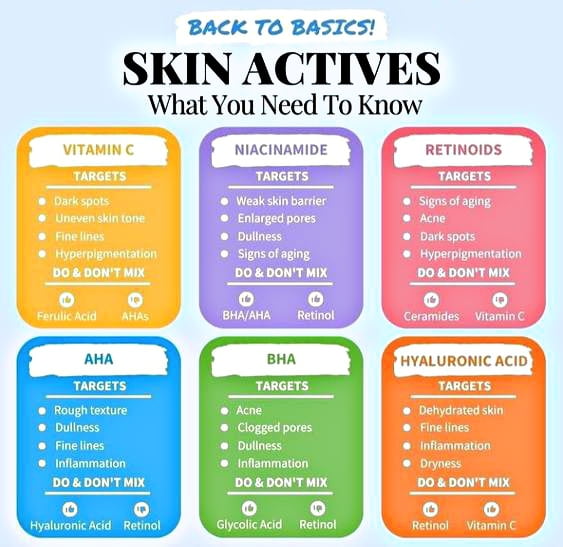What are actives in skin care? Actives in skincare are ingredients that directly target skin concerns like wrinkles, acne, or hyperpigmentation, providing noticeable changes to the skin’s appearance and health. This guide will help you navigate the world of actives to achieve radiant, healthy skin.

Image Source: www.beautywithfam.com
The Significance of Skincare Ingredients
Why are skincare ingredients so important? Well, the products you put on your skin can either protect it or damage it. Choosing the right active ingredients can make a big difference in how your skin looks and feels. Actives aren’t just about surface-level improvements; they work at a deeper level to stimulate cell turnover, boost collagen production, and combat various skin issues.
What Distinguishes Active Ingredients?
Not all skincare components are created equal. While some, like moisturizers and cleansers, support the skin’s barrier and remove impurities, actives go a step further. They bring about a measurable change in the skin. We’re talking about reducing wrinkles, clearing up acne, fading dark spots, and improving overall skin texture.
Cosmetic Actives vs. Inactive Ingredients
Understanding the difference between cosmetic actives and inactive ingredients is crucial. Inactive ingredients, also known as excipients or carriers, help deliver actives into the skin. They ensure that the active ingredients are stable, absorb properly, and feel nice on the skin.
Think of it like this: the active ingredient is the key player in a sports team, while the inactive ingredients are the supporting staff that ensures the player performs well.
Decoding Types of Actives
The world of skincare actives is vast, and each type offers unique benefits of actives. Here’s a breakdown of some of the most common and potent ingredients:
Retinoids: The Gold Standard for Anti-Aging
Retinoids, including retinol, tretinoin, and retinaldehyde, are derivatives of Vitamin A. They are celebrated for their anti-aging properties and effectiveness in treating acne.
- Benefits: Reduces fine lines and wrinkles, improves skin texture, unclogs pores, and boosts collagen production.
- How they work: Retinoids speed up cell turnover, bringing fresh, new cells to the surface faster.
- Usage: Start with a low concentration and gradually increase as your skin tolerates it. Use at night and always wear sunscreen during the day, as retinoids can make your skin more sensitive to the sun.
Alpha Hydroxy Acids (AHAs): Exfoliation Powerhouses
AHAs, such as glycolic acid and lactic acid, are chemical exfoliants that dissolve the bonds between dead skin cells.
- Benefits: Smooths skin texture, reduces hyperpigmentation, improves skin tone, and boosts radiance.
- How they work: AHAs exfoliate the surface of the skin, revealing brighter, newer skin underneath.
- Usage: Use in the evening, and be sure to wear sunscreen during the day. Start with a low concentration and gradually increase as needed.
Beta Hydroxy Acids (BHAs): Deep Pore Cleansers
BHAs, primarily salicylic acid, are oil-soluble exfoliants that penetrate pores to dissolve oil and debris.
- Benefits: Treats acne, unclogs pores, reduces blackheads and whiteheads, and calms inflammation.
- How they work: BHAs exfoliate both the surface of the skin and inside the pores.
- Usage: Use one to two times per day, as needed. Be cautious when combining with other exfoliating actives to avoid over-exfoliation.
Vitamin C: The Antioxidant Superstar
Vitamin C, also known as L-Ascorbic Acid, is a powerful antioxidant that protects the skin from free radical damage.
- Benefits: Brightens skin, reduces hyperpigmentation, boosts collagen production, and protects against environmental damage.
- How it works: Vitamin C neutralizes free radicals, preventing them from damaging skin cells.
- Usage: Use in the morning to protect your skin from daytime environmental aggressors.
Niacinamide: The Multi-Tasker
Niacinamide, a form of Vitamin B3, is a versatile active with numerous benefits for the skin.
- Benefits: Reduces redness and inflammation, minimizes pore appearance, improves skin texture, and strengthens the skin barrier.
- How it works: Niacinamide helps regulate oil production, reduces inflammation, and strengthens the skin’s natural barrier function.
- Usage: Can be used in the morning or evening. It’s generally well-tolerated and can be combined with other actives.
Hyaluronic Acid: The Hydration Hero
Hyaluronic acid (HA) is a humectant that draws moisture from the air into the skin.
- Benefits: Hydrates skin, plumps fine lines and wrinkles, and improves skin elasticity.
- How it works: HA attracts and binds water to the skin, keeping it hydrated and supple.
- Usage: Can be used in the morning and evening. It’s often included in serums and moisturizers.
Ceramides: Skin Barrier Protectors
Ceramides are lipids (fats) that are naturally found in the skin. They play a vital role in maintaining the skin barrier.
- Benefits: Strengthens the skin barrier, reduces moisture loss, and protects against environmental irritants.
- How it works: Ceramides help to replenish the skin’s natural lipid barrier, improving its ability to retain moisture.
- Usage: Can be used in the morning and evening. Often found in moisturizers.
Fathoming Skincare Formulation
The effectiveness of effective skincare depends not only on the active compounds themselves but also on how they are formulated. Skincare formulation is the art and science of combining ingredients in a way that maximizes their efficacy while minimizing potential irritation.
The Importance of pH Levels
The pH level of a product can affect how well an active ingredient works. For example, AHAs and BHAs are most effective at a lower pH (around 3-4). Formulators must carefully adjust the pH to optimize the active’s performance.
Delivery Systems
How an active ingredient is delivered to the skin matters. Some actives need to penetrate deep into the skin, while others work best on the surface. Delivery systems, such as liposomes or microencapsulation, can help ensure that actives reach the right layers of the skin.
Concentration Matters
The concentration of an active ingredient is critical. Too little, and it won’t be effective; too much, and it could cause irritation. Finding the right balance is essential for achieving the desired results.
Synergy and Interactions
Some actives work well together, while others can interfere with each other. For example, combining Vitamin C with Vitamin E can boost their antioxidant effects. However, using retinoids and AHAs at the same time can cause excessive irritation.
Building Your Active Skincare Routine
Creating an effective skincare routine with actives requires careful planning and consideration of your skin type and concerns.
Identify Your Skin Type and Concerns
Before incorporating actives, determine your skin type (dry, oily, combination, or sensitive) and identify your primary skin concerns (acne, wrinkles, hyperpigmentation, etc.). This will help you choose the right actives for your needs.
Start Slowly
Don’t rush into using multiple actives at once. Introduce one new active at a time, allowing your skin to adjust before adding another. This helps you identify any potential irritations or reactions.
Patch Test
Before applying a new active to your entire face, perform a patch test on a small area of skin (e.g., behind your ear or on your inner arm). This can help you determine if you’re sensitive to the ingredient.
Layering Actives
The order in which you apply your skincare products can affect their efficacy. Generally, apply products from thinnest to thickest consistency. Water-based serums should go on before oil-based products.
Sun Protection is Non-Negotiable
Actives like retinoids and AHAs can make your skin more sensitive to the sun. Wearing broad-spectrum sunscreen with an SPF of 30 or higher every day is crucial to protect your skin and prevent sun damage.
Hydration is Key
Actives can sometimes be drying or irritating. Incorporating hydrating products, such as hyaluronic acid serums or ceramide-rich moisturizers, can help keep your skin balanced and comfortable.
Navigating Potential Side Effects
While actives can deliver amazing results, they can also cause side effects, especially when used incorrectly.
Common Side Effects
- Redness: Many actives, like retinoids and AHAs, can cause temporary redness.
- Peeling: Exfoliating actives can cause peeling as they remove dead skin cells.
- Dryness: Actives can strip the skin of moisture, leading to dryness and flakiness.
- Irritation: Some actives can cause itching, burning, or stinging, especially in those with sensitive skin.
- Purging: Actives that speed up cell turnover can cause purging, where breakouts temporarily worsen before improving.
How to Manage Side Effects
- Reduce Frequency: If you experience side effects, reduce the frequency of use.
- Use Lower Concentrations: Opt for products with lower concentrations of actives.
- Buffer with Moisturizers: Apply a moisturizer before or after the active to reduce irritation.
- Take Breaks: Give your skin breaks from actives to allow it to recover.
- Consult a Dermatologist: If side effects persist or worsen, consult a dermatologist.
Diving into Cosmeceuticals
Cosmeceuticals are products that have both cosmetic and pharmaceutical benefits. They contain actives that can affect the skin at a deeper level, offering more significant results than traditional cosmetics.
Examples of Cosmeceutical Ingredients
- Growth Factors: Stimulate collagen production and promote skin repair.
- Peptides: Short chains of amino acids that can boost collagen and reduce wrinkles.
- Stem Cells: Plant-derived stem cells that can protect skin cells from damage.
Regulation of Cosmeceuticals
Unlike drugs, cosmeceuticals are not regulated by the FDA. This means that manufacturers are not required to prove their efficacy or safety before selling them. It’s important to research cosmeceutical products carefully and choose reputable brands.
Choosing the Right Actives for Your Skin
Selecting the right actives depends on several factors, including your skin type, skin concerns, and tolerance levels.
For Dry Skin
- Hyaluronic Acid: To hydrate and plump the skin.
- Ceramides: To strengthen the skin barrier and prevent moisture loss.
- Niacinamide: To improve skin texture and reduce redness.
For Oily Skin
- Salicylic Acid (BHA): To unclog pores and treat acne.
- Niacinamide: To regulate oil production and minimize pore appearance.
- Retinoids: To unclog pores and reduce inflammation.
For Combination Skin
- AHA/BHA Blend: To exfoliate and unclog pores.
- Hyaluronic Acid: To hydrate dry areas.
- Vitamin C: To brighten skin and protect against environmental damage.
For Sensitive Skin
- Niacinamide: To reduce redness and strengthen the skin barrier.
- Ceramides: To protect and repair the skin barrier.
- Azelaic Acid: To treat acne and reduce inflammation gently.
Spotting the Myths Surrounding Actives
There are many misconceptions about actives in skincare. Let’s debunk some of the most common myths.
Myth #1: More is always better.
Truth: Using too many actives or using them at high concentrations can lead to irritation and damage.
Myth #2: Actives are only for older skin.
Truth: Actives can benefit people of all ages. For example, salicylic acid can help teenagers with acne, while Vitamin C can protect younger skin from sun damage.
Myth #3: Natural actives are always better.
Truth: Just because an ingredient is natural doesn’t mean it’s effective or safe. Some natural ingredients can be irritating or allergenic.
Myth #4: All retinoids are the same.
Truth: Retinoids come in different forms and strengths. Tretinoin is the most potent and requires a prescription, while retinol and retinaldehyde are weaker and available over-the-counter.
Myth #5: You’ll see results immediately.
Truth: It takes time for actives to work. Most actives require several weeks or months of consistent use to produce noticeable results.
FAQ: Frequently Asked Questions
Q: Can I use Vitamin C and Retinol together?
A: It’s generally recommended to use Vitamin C in the morning and Retinol at night, as they can sometimes cause irritation when used together.
Q: What is the best active ingredient for acne?
A: Salicylic acid (BHA) is a popular and effective choice for treating acne because it unclogs pores and reduces inflammation.
Q: Who is a good candidate for using active ingredients in their skincare routine?
A: Most people can benefit from active ingredients, but it’s essential to start slowly, patch test, and choose actives that are appropriate for your skin type and concerns.
Q: Can I use too many active ingredients at once?
A: Yes, using too many actives at once can lead to irritation, dryness, and other side effects. Introduce one new active at a time and monitor your skin’s reaction.
Q: What’s the difference between retinol and retinoids?
A: Retinoids is the umbrella term for all Vitamin A derivatives, while retinol is just one type of retinoid, typically found in over-the-counter products. Other retinoids include retinaldehyde and prescription-strength tretinoin.
In conclusion, actives in skincare are powerful tools for achieving radiant, healthy skin. By grasping the different types of actives, how they work, and how to use them correctly, you can create a personalized skincare routine that addresses your unique skin concerns and helps you achieve your desired results.

I’m Carrie Kelly, the creator behind Gotham Beauty Lounge. Beauty is my passion, and I’ve made it my mission to bring you all the latest trends, expert tips, and honest reviews to help you elevate your beauty game. With a love for all things bold, edgy, and elegant, I believe makeup is an art form, and skincare is self-care. On my blog, I share my personal experiences, favorite products, and advice for embracing your unique beauty. Join me on this exciting journey to feel confident, empowered, and, most importantly, to always look and feel your best!
